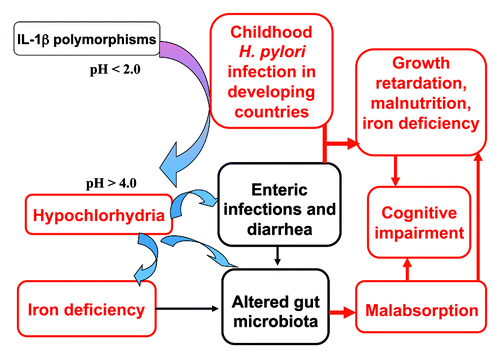Figures & data
Figure 1. Potential multiple outcomes of childhood H. pylori infection in developing countries. Infection with H. pylori is frequent in children in developing countries.Citation2H. pylori infection is accompanied by a period of hypochlorhydria for several months. Hypochlorhydria in H. pylori infected children has been associated with iron deficiency.Citation6 Polymorphisms in IL-1β gene cluster may control the extent and duration of hypochlorhydria with initial H. pylori infection. Pro-inflammatory polymorphisms in the IL-1β gene cluster in H. pylori infected children are associated with hypoferritinaemia and reduced hemoglobin concentrations.Citation7 The period of hypochlorhydria associated with H. pylori infection in poor resource settings is a potential window for the acquisition of other enteric infections and diarrheal disease.Citation90,Citation91 The clinical consequences and potential synergism between H. pylori infection and diarrheal disease in poor resource settings will promote not only malnutrition and growth impairment, but also cognitive impairment.Citation150 The hypochlorhydria induced by H. pylori infection may also result in alterations in the gut microbiota and contribute to small intestinal permeability changes and malabsorption, thus also impacting on malnutrition and growth impairment.
